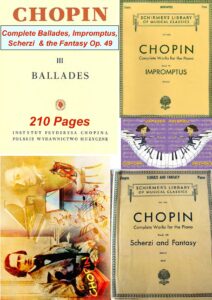Chopin – Étude Op 10 No 3 in E Major “Tristesse” – with sheet music
Browse in the Library:
Or browse in the categories menus & download the Library Catalog PDF:

Chopin’s Études
The term “étude” has long been used to describe pieces of technical, sometimes virtuosic, difficulty, focused on training and refining a specific aspect of a performer’s technique. Masters such as Czerny and Hanon wrote notorious etudes that are legendary exercises in finger and hand dexterity and strength. Although invaluable in this regard, these etudes are lacking in musical development, since most of them are merely repetitions of the same general pattern of notes. They have no inherent musicality.
Chopin’s etudes are special in this regard. These etudes inspired many Chopin enthusiasts to seek a piano teacher, so that they can emulate the great composer. Chopin was the first to pioneer the etude into an actual art form. Although all of his twenty-seven etudes for piano adhere to the basic principle of an etude – to train and refine a specific aspect of a performer’s technique – there is another element present.Each of the etudes, rather than being a dry repetitive exercise, has its own musical story to tell. Like virtually all of Chopin’s compositions, there is an emotional aspect that transcends the mere playing of notes, and takes a true virtuoso to execute well. This newly developed musical aspect of the etude persisted as a feature of Romantic repertoire; among the other great Romantics, Liszt was particularly famous for his technically intense yet passionate concert etudes.
Chopin named very few of his own compositions, almost always preferring to refer to them by opus and number. His etudes were no exception. However, due to their passionate, Chopin-esque nature, many of the etudes have nicknames given either by enthusiastic editors or zealous fans. These programmatic titles have been noted where they are present. Again, it is important to note that Chopin himself did not come up with any of these titles, and most likely even disapproved of them.
One should also note that while each of the etudes focus on a specific aspect of the performer’s technique, all are tied together by a common thread. Even though the Etude Op. 10 No. 1 is a difficult exercise in broad arpeggiated chords and the Etude Op. 25 No. 10 is a taxing study for octave technique, they share something in common.Every one of Chopin’s twenty-seven etudes, in addition to what each specifically focuses on, is an exercise designed to develop a legato style of playing. Chopin’s severest criticism of his pupils was that “S/he does not know how to connect two notes”; nowhere is this philosophy more evident than in his etudes.
Chopin has truly brought about a complete overhaul of the etude art form. He has transformed it from a dry, technical exercise into a lively, emotional story that at the same time develops the pianist’s technique. In this, they are truly Revolutionary.
Etudes Op. 10, 1829-1833: [No. 1-12]
The twelve Etudes Op. 10 were all written when Chopin was between the ages of nineteen and twenty-three – many of them before he had reached legal manhood. Despite this, many of them are tricky even for professionals, and have vexed many a brave soul. They are dedicated to “Son ami Franz Liszt” (“His friend Franz Liszt”), whom he met while performing in the salons of Paris.
Op.10 No. 3, E major (Tristesse)
The popular Etude Op. 10 No. 3 is set apart from many of the other Op. 10 and Op. 25 etudes most noticeably by its tempo. While many of the others in these two sets are whirlwinds of notes, this one is calmer and much slower. It is also, however, incredibly emotional and musical.
The primary technical focus here is playing in three voices. The right hand plays the melody and the left hand plays accompanying notes. However, there is a third sixteenth-note accompaniment “between” the melody and bass, played by both hands. In the middle of the piece, the difficulty shifts to fast playing of chromatic fourths, which could pose a challenge to pianists who could otherwise handle this piece with ease.
What makes this particular etude notable, however, is not its technical difficulty. It is the nostalgia, the wistfulness, and the emotion that flow through the music. Chopin is rumored to have proclaimed about this etude that “In all my life I have never again been able to find such a beautiful melody.” It is also reported that while Chopin was playing this for a student, he suddenly began weeping and cried “Oh, my homeland!” This etude is one of the best expressions of Chopin’s nationalism and the love he felt for his Poland.
While the piece is undoubtedly very emotional, many musicians believe that it is poorly nicknamed. Tristesse, which translates to sadness, is a misnomer, to say the least. The etude is not simply “sad”; it is an expression of nostalgia and Chopin’s love of his homeland. It has firmly established itself as one of Chopin’s most popular and best loved compositions.
Browse in the Library:
Or browse in the categories menus & download the Library Catalog PDF:
